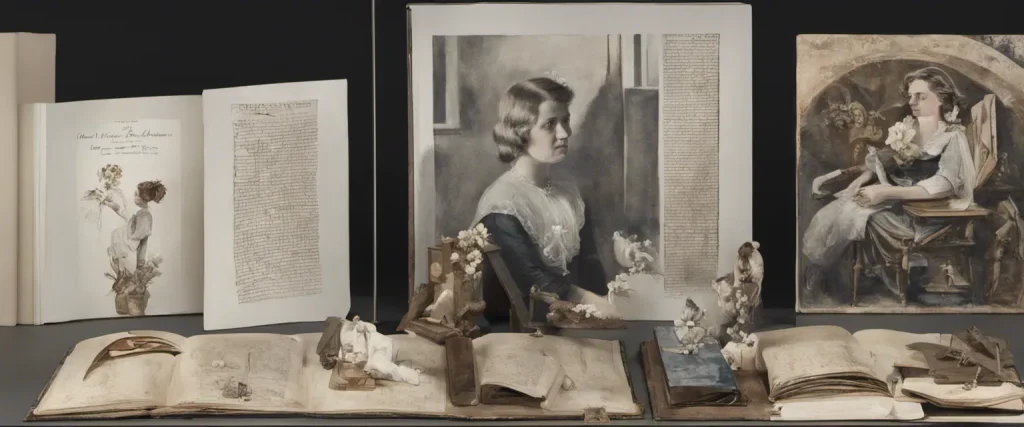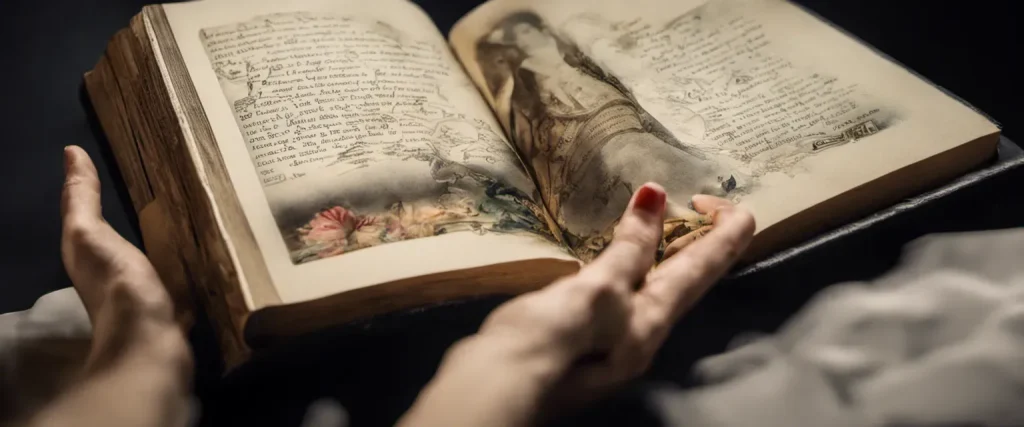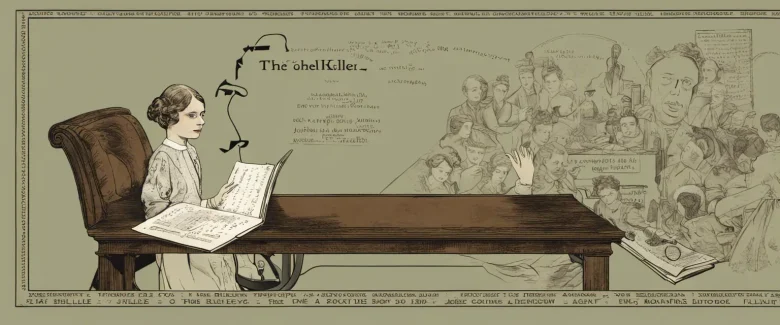In “The Story of My Life” by Helen Keller, readers are given a remarkable account of resilience and triumph as the author recounts her own extraordinary journey. Helen Keller, an American author, lecturer, and political activist, was born in Tuscumbia, Alabama, in 1880. At the tender age of 19 months, she was struck by an illness that rendered her both deaf and blind. Despite these immense challenges, Helen Keller went on to not only learn to communicate, but to unravel the depths of knowledge and touch the hearts of millions worldwide. As we delve into her inspiring narrative, we witness Helen’s indomitable spirit and her unyielding pursuit of educational opportunities that eventually led her to become an influential advocate for the rights of the disabled.
Chapter 1: Early Childhood and Illness
In Chapter 1 of “The Story of My Life,” Helen Keller describes her early childhood and the onset of her illness. Helen was born in Tuscumbia, Alabama, in 1880, and she narrates her earliest memories, like feeling the warmth of the sun and playing with her younger sister, Mildred. Being born a healthy child, Helen was full of curiosity and natural impulses to explore her surroundings.
However, tragedy struck when Helen was nineteen months old. She became extremely ill, and the doctor diagnosed her illness as “acute congestion of the stomach and the brain.” This mysterious illness left her blind and deaf, making her world suddenly dark and silent. She refers to this time as her “soul’s sudden awakening,” as she realized her communication and connection with the outside world had been severed.
Struggling to comprehend her new reality, Helen recalls feeling trapped in her own mind. She became frustrated with her inability to understand or express herself, leading to frequent tantrums. Helen’s parents, especially her mother, were deeply concerned about her development. They spared no effort to seek advice and treatments for her, despite the limited resources available at the time.
Finally, a glimmer of hope emerged when Helen’s parents learned about Alexander Graham Bell’s successful work with the deaf. They contacted him and he suggested they reach out to the Perkins Institution for the Blind in Boston, where they could find guidance and support for Helen’s education. The chapter concludes with Helen’s parents taking her to see Dr. Alexander Graham Bell himself, setting the stage for the events to come in Helen’s extraordinary life.
Through these recollections, Helen Keller introduces readers to her journey from a curious and vivacious toddler to a child confronted with immense challenges. While the chapter primarily focuses on the initial stages of her illness, it also highlights the determination and love of her family, key elements that would prove crucial in shaping the remarkable life that lay ahead of her.
Chapter 2: The Arrival of Anne Sullivan
Chapter 2: The Arrival of Anne Sullivan, from the book The Story of My Life by Helen Keller, recounts the life-changing moment when a young and determined teacher named Anne Sullivan enters Helen’s world. The chapter begins with Helen describing her frustration and isolation caused by her inability to communicate effectively.
Helen recalls one particular day when her world dramatically changed. Anne Sullivan arrives at Helen’s home, and from the moment she steps off the carriage, Helen senses her arrival without seeing or hearing her. It becomes evident that Anne is determined to teach Helen how to communicate and connect with the world.
The chapter goes on to describe the initial confrontation between Helen and Anne. Helen, used to having her own way and resistant to change, does not welcome Anne’s arrival. A battle of wills ensues as Helen rebelliously rejects Anne’s attempts to teach her.
However, Anne remains steadfast, refusing to give in to Helen’s challenging behavior. She uses persistence and determination to break through Helen’s defenses. Helen’s parents eventually give Anne unrestricted control, knowing she holds the key to unlocking their daughter’s potential.
Anne’s first task is to teach Helen discipline and establish control over her unruly behavior. Using unconventional methods, Anne employs a combination of pressure and guidance to reshape Helen’s behavior. Slowly but surely, Helen begins to understand that Anne is not her enemy but rather her ally.
As the chapter draws to a close, Helen describes the breakthrough moment when the true meaning of language first dawns on her. Through patience and perseverance, Anne finally helps Helen make the connection between the physical world and its abstract representation in words.
In Chapter 2, the arrival of Anne Sullivan marks the beginning of Helen Keller’s extraordinary journey towards learning and communication. It portrays the transformative impact of a dedicated teacher who refuses to give up on a seemingly hopeless pupil.
Chapter 3: Learning to Communicate
In Chapter 3 of “The Story of My Life” by Helen Keller, titled “Learning to Communicate,” Helen recounts the breakthrough moment when her teacher, Anne Sullivan, taught her the meaning of words and how to communicate effectively.
At first, Helen describes feeling frustrated and isolated. She remembers being able to communicate only through rudimentary gestures, which led to misunderstandings and a lack of true connection with others. Helen’s parents, realizing her potential, sought out a teacher who could help her overcome these communication barriers.
Anne Sullivan arrived in Helen’s life, armed with patience, intelligence, and a deep understanding of Helen’s struggles. Anne recognized that Helen’s first hurdle was associating objects with their names. One particular significant moment occurred when Anne pumped water from a well and spelled out the word “water” on Helen’s hand. Helen instantly grasped the concept; she understood that everything had a name and that words were symbols for objects and actions. This breakthrough not only opened the world of communication for Helen but also ignited her love for learning.
With Anne’s guidance, Helen made tremendous progress in a short span of time. Anne constantly expanded her vocabulary by teaching her various words and their meanings. Helen recalls the joy she felt when she could finally express her thoughts and ideas to others. She eagerly imitated the sounds and speaking patterns of those around her, eventually learning to form sentences and engage in conversations.
Overall, Chapter 3 highlights Helen Keller’s transformative experience of learning how to communicate through the defining moment of understanding the connection between words and objects, thanks to her dedicated teacher, Anne Sullivan.
Chapter 4: Education and Exploration

In Chapter 4 of “The Story of My Life” by Helen Keller, the focus is on her education and exploration. The chapter begins with Helen expressing her joy in learning new concepts and discovering the world around her.
Throughout this section, Helen describes how she learned to communicate effectively. Under the guidance of her teacher, Anne Sullivan, she started to spell words on her palm using the manual alphabet. This breakthrough greatly excited Helen as she realized that words represented objects and concepts. She soon began spelling every word she came across, eagerly soaking up knowledge and widening her understanding of the world.
Helen’s education expanded beyond basic language skills and extended into exploring different subjects. She learned arithmetic, reading, writing, and even dabbled in Latin. Helen found particular pleasure in reading, as it opened up a cascade of new ideas and stories. She devoured books, especially those that discussed nature and the sciences, enabling her to view the world in new and fascinating ways.
The chapter also highlights Helen’s explorations in nature. She developed an intense fascination with plants and animals, as well as the intricacies of the natural world. She absorbed herself in observing and studying her surroundings, marvelling at the nuances of life that many take for granted.
Furthermore, Helen expresses gratitude towards her teacher, Anne Sullivan, for unlocking the door to knowledge and leading her on this incredible educational journey. She demonstrates her continuous hunger for learning and the independence that education has brought her. Ultimately, this chapter serves as a testament to Helen Keller’s unyielding determination to overcome her disabilities, embrace education, and explore the magnificence of the world around her.
Chapter 5: Overcoming Challenges
Chapter 5 of “The Story of My Life” by Helen Keller focuses on her efforts to overcome various challenges and obstacles in her quest for education and communication.
The chapter begins with Helen’s move from her quiet, isolated life in the country to the city of Boston. Here, Helen discovers that the real world is vastly different from what she had known before. She finds herself surrounded by noise and commotion, making it difficult for her to orient herself in this new environment. However, she adapts quickly and embraces the fast pace and lively atmosphere of the city.
One of Helen’s primary challenges is learning to communicate effectively. She faces several obstacles in this regard, the first being her difficulty in expressing herself through spoken language. Despite her desire to be understood, others struggle to comprehend her words due to her lack of training in articulation. Determined to overcome this barrier, Helen tirelessly works on improving her speech with the help of her beloved teacher, Anne Sullivan.
Helen also faces challenges in reading and writing. Although she is initially disheartened by her inability to understand the written word, Anne introduces her to a new method of communication—the manual alphabet. This system provides Helen with a breakthrough, enabling her to make rapid progress in spelling and reading. With this newfound skill, she embarks on a journey of knowledge, devouring books and gaining a deep appreciation for literature.
Throughout the chapter, Helen expresses her determination to overcome any obstacles that may hinder her path to self-improvement. She recognizes that her greatest adversaries are not physical disabilities, but rather her own impatience and frustration. By facing these challenges head-on and persistently working towards her goals, Helen proves that nothing can hinder her determination to lead a fulfilling and meaningful life.
Chapter 6: College Years and Advocacy
Chapter 6 of the book “The Story of My Life” by Helen Keller focuses on her college years and her advocacy work. This chapter explores Helen’s entrance into Radcliffe College, her experiences and challenges during her time there, as well as her growing interest in advocating for the rights of the disabled.
After completing her studies at the Cambridge School, Helen was admitted to Radcliffe College in 1900. She was the first deaf and blind person to ever attend this prestigious institution. Despite the initial doubts and skepticism from her professors and peers, Helen quickly proved herself as an intelligent and capable student. She excelled in her studies, particularly in subjects like English, French, and German. Helen was required to read texts in Braille, but she also learned to understand and appreciate literature through the assistance of her teachers and companions.
During her college years, Helen became increasingly aware of the limitations and discrimination faced by individuals with disabilities. This realization fueled her passion for advocacy and she became deeply committed to fighting for the rights of the disabled. Helen understood the importance of education in empowering individuals and enabling them to live fulfilling lives. She realized that education was the key to breaking down the barriers imposed by society.
As Helen delved into social and political issues, she attended conferences and meetings where she voiced her opinions and ideas. Her speeches and writings became noteworthy, and her advocacy work gained recognition and respect. Helen’s determination and intellect drew attention, and her words inspired countless others to join her cause.
In summary, Chapter 6 of “The Story of My Life” details Helen Keller’s transformative college years, where she relentlessly pursued her education and discovered her passion for advocacy. Her experiences at Radcliffe led her to recognize the injustice faced by disabled individuals, and she became a powerful advocate, using her voice to raise awareness and fight for their rights.
Chapter 7: Travels and Experiences
Chapter 7 of “The Story of My Life” by Helen Keller details her experiences traveling to various places and the challenges she faced as a deaf-blind individual. The chapter begins with Helen and her teacher, Anne Sullivan, embarking on a journey to Washington, D.C. to attend the inauguration of President Benjamin Harrison. Despite being unable to hear or see the ceremony, Helen describes feeling the vibrancy and excitement of the crowd through touch and vibrant sensations.
Following her trip to Washington, Helen and Anne travel to Boston, where they visit the Perkins Institution for the Blind. Helen is both inspired and saddened by her encounters with other blind individuals who have learned to communicate through sign language or Braille. This experience reinforces her determination to continue learning and overcoming the barriers of her disabilities.
Upon returning to their home in Tuscumbia, Helen and Anne embark on a journey to the East Coast, visiting cities such as Boston, New York, Philadelphia, and Baltimore. While exploring these cities, Helen is exposed to diverse environments, architecture, and cultural experiences. She recalls visits to museums, zoos, and historical landmarks, expressing her fascination with the tangible aspects of these places that she can touch and feel.
Throughout the journey, Helen’s senses continue to develop, and her vocabulary expands as she learns the names of various objects she encounters. She acknowledges that her experiences, although unique, have allowed her to gain a deeper understanding of the world around her.
In conclusion, Chapter 7 chronicles Helen Keller’s travels and experiences, highlighting her ability to connect with the world through her remaining senses. Her encounters with other blind individuals deepen her resolve to communicate and overcome her own limitations. The chapter also emphasizes her growing knowledge and vocabulary, as well as her capacity to appreciate the diverse environments and cultural landmarks she explores.

Chapter 8: Legacy and Reflections
Chapter 8: Legacy and Reflections, the final chapter of Helen Keller’s autobiography, “The Story of My Life,” reflects on the impact she has made through her accomplishments and draws conclusions about her own experiences.
Keller begins by discussing her personal philosophy, emphasizing the importance of perseverance and the belief that life’s challenges can be overcome. She credits the undying support of her teacher, Anne Sullivan, for enabling her to triumph over her disabilities. Keller highlights how Sullivan not only taught her language and knowledge but also nurtured her spirit, giving her the determination to persevere and achieve greatness.
Next, Keller contemplates her legacy and the contributions she has made to society. Despite facing overwhelming odds, she became the first deaf-blind person to earn a college degree, which inspired others with disabilities to believe in their own potential. Keller recognizes that her story serves as a symbol of hope and represents the indomitable human spirit.
Reflecting on her journey, Keller expresses gratitude for the opportunities she has been given and the love she has received throughout her life. She acknowledges the privilege of being able to communicate with others through Braille, speech, and lip-reading, enabling her to connect with the world in ways she once thought impossible.
In the final pages of the chapter, Keller muses on the beauty of language and how it empowers individuals to express their deepest thoughts and emotions. She marvels at the intricate nuances and incredible power of words, witnessing their ability to shape and influence the world.
In summary, Chapter 8 of “The Story of My Life” encapsulates Helen Keller’s reflections on the significance of her achievements, her lasting impact on society, and her appreciation for language. Through her journey, Keller has become an emblem of perseverance, inspiring countless individuals to overcome their own obstacles and find strength within themselves.
After Reading
In conclusion, “The Story of My Life” by Helen Keller is a touching and inspirational memoir that chronicles the remarkable journey of a girl who overcame the limitations of being deaf and blind. Through the tireless efforts of her teacher, Anne Sullivan, Helen was able to learn language and communication, which ultimately opened up a world of possibilities for her. This book serves as a testament to the indomitable human spirit and the power of determination, reminding us that with perseverance and support, anything is possible. Helen Keller’s story continues to inspire readers of all ages, encouraging them to embrace challenges and never give up on their dreams.
1. “The Miracle Worker” by William Gibson: This play captures the remarkable story of Helen Keller and her lifelong companion and teacher, Anne Sullivan. It delves deeper into their inspiring journey, detailing their perseverance and the transformative power of education. It offers an emotional and vivid portrayal of Keller’s struggles and ultimate triumph over adversity.
2. “The Hiding Place” by Corrie ten Boom: This powerful memoir chronicles the life of Corrie ten Boom, a Dutch woman who helped Jewish refugees during World War II and was later imprisoned in a Nazi concentration camp. Similar to Helen Keller’s story, ten Boom’s tale is a moving testament to the indomitable spirit of the human soul and the power of hope in the darkest of times.
3. The Diary of a Young Girl” by Anne Frank: This poignant and timeless diary captures Anne Frank’s experiences during the Holocaust. Much like Helen Keller, Anne Frank faced immense challenges and demonstrated incredible resilience. This book offers a unique perspective on the human capacity for hope and the importance of preserving one’s spirit in the face of adversity.
4. The Immortal Life of Henrietta Lacks” by Rebecca Skloot: This captivating non-fiction book delves into the life of Henrietta Lacks, an African American woman whose cells were unwittingly taken and used for medical research. With parallels to Helen Keller’s quest for knowledge and understanding, this book explores themes of ethics, race, and scientific discovery, shedding light on the remarkable impact one person can have on the world.
5. “The Glass Castle” by Jeannette Walls: This memoir tells the story of Walls’ unconventional and turbulent childhood, growing up with parents who were eccentric and often neglectful. Walls’ resilient spirit and determination echo Helen Keller’s own journey towards independence and self-discovery. This emotionally charged memoir emphasizes the importance of dreaming, overcoming obstacles, and finding strength in unexpected places.



